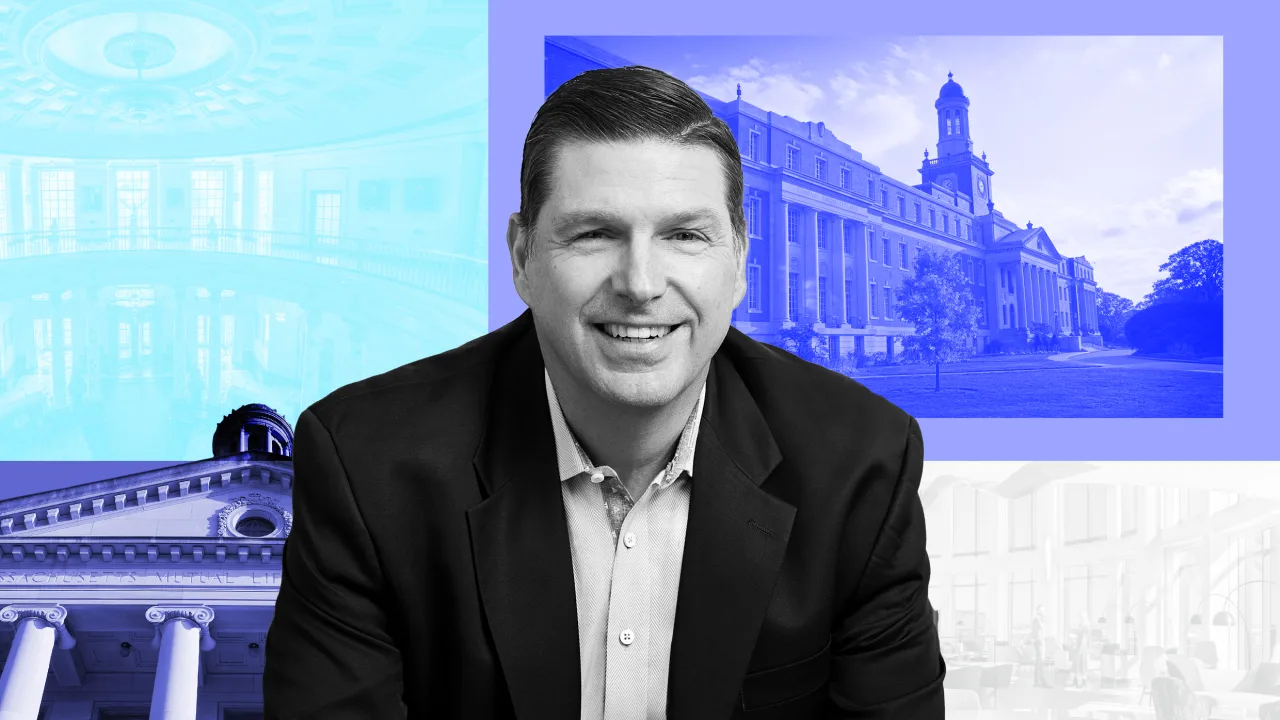You don’t get to be 173 years old without this leadership trait
Hello and welcome to Modern CEO! I’m Stephanie Mehta, CEO and chief content officer of Mansueto Ventures. Each week this newsletter explores inclusive approaches to leadership drawn from conversations with executives and entrepreneurs, and from the pages of Inc. and Fast Company. If you received this newsletter from a friend, you can sign up to get it yourself every Monday morning. Roger Crandall likes to say that he stands on the shoulders of people who made economic decisions generations before he became CEO of MassMutual, the mutual life insurance company founded in 1851. Previous CEOs not only navigated the company through the Civil War, two World Wars, the Great Depression, and other periods of financial tumult, but often found ways to strengthen the business in the process. Crandall recalls how MassMutual and other insurers emerged from challenges to their business in the 1970s and early 1980s with new products. At the time, insurance companies started to feel squeezed because permanent life insurance customers were able to borrow against the cash value of their policies at fixed rates of 5% to 8%. Those rates were below the 30-year-mortgage fixed rate, which had soared to 18% by October 1981. At the same time, insurers saw the value of bonds, normally a conservative investment in their portfolios, drop. MassMutual had the capital to get through the high interest rate environment, Crandall says. However, in response to these changes, the industry developed a product that allowed insurance companies to make loans to policyholders at variable rates tied to long-term interest rates. The new policies “still gave people a valuable benefit, but in a way that also was going to keep the company resilient,” he says. (Consumer groups pushed back on the changes, bemoaning the loss of cheap credit.) Leadership’s must-have quality CEOs and leadership experts differ on what the top quality for leaders should be. Earlier this year, Tim Ryan, former PwC senior partner, told Modern CEO that humility is the “No. 1 quality or characteristic CEOs need to have,” which prompted readers to suggest authenticity and empathy are more important. But Crandall makes the case that resilience also needs to be a priority, especially given the complexity and pace of change leaders need to navigate. A pulse survey KPMG conducted earlier this year found that 78% of CEOs polled were confident in their companies’ ability to grow, with 67% saying they were making “significant” strategic adjustments in response to geopolitical uncertainty. “For all CEOs, resiliency is important, because volatility is both an opportunity and a risk,” Crandall says. “What resilience ultimately lets you do is roll with the punches and make sure that you come out of situations not just surviving, but thriving and being stronger.” Resilience in action Crandall says his pre-pandemic decision to address challenges in attracting talent—including financial, investment, and tech professionals—by expanding the Springfield, Massachusetts–based company’s footprint in Boston “created the base of a resilient company to allow us to compete and win for talent long term.” To be clear, “resilience” isn’t just bouncing back from adversity—it’s taking a challenge and growing from it, making improvements, or, as Crandall says, emerging stronger. The Black Swan author Nassim Nicholas Taleb calls this “antifragility,” or gaining from disorder. Executives can debate whether antifragility is the No. 1 trait leaders need, but there’s no question resilience should be part of any CEO’s toolkit. In MassMutual’s case, resilience has given the company its longevity (it is 173 years old). And longevity, in turn, is key to MassMutual’s business, which involves making long-term commitments to policyholders. Crandall cites the example of a 102-year-old customer whose policy has been in force for 92 years. He says: “For us, resiliency is critical because it’s at the core of what we do with multigenerational promises.” How does your company build resilience? How has your organization shown resilience—or gained from disorder? Send your examples to stephaniemehta@mansueto.com. I will feature examples in a future newsletter. Reader Mailbag Last month I asked readers to share their insights on how they balance profit and purpose. Michele Malejki, global head of social impact at HP and director of the HP Foundation, shared information about the Digital Equity Accelerator, which helps nonprofits scale their impact. The project is aligned with HP’s core business—selling technologies such as PCs, printers, and accessories—as well as its social commitments in climate action, human rights, and digital equity. “HP is committed to ensuring people are ready for the future of work with access to quality education and the digital skills that drive learning and economic opportunities,” Malejki writes. “As the digital economy grows, the gap between those

Hello and welcome to Modern CEO! I’m Stephanie Mehta, CEO and chief content officer of Mansueto Ventures. Each week this newsletter explores inclusive approaches to leadership drawn from conversations with executives and entrepreneurs, and from the pages of Inc. and Fast Company. If you received this newsletter from a friend, you can sign up to get it yourself every Monday morning.
Roger Crandall likes to say that he stands on the shoulders of people who made economic decisions generations before he became CEO of MassMutual, the mutual life insurance company founded in 1851. Previous CEOs not only navigated the company through the Civil War, two World Wars, the Great Depression, and other periods of financial tumult, but often found ways to strengthen the business in the process.
Crandall recalls how MassMutual and other insurers emerged from challenges to their business in the 1970s and early 1980s with new products. At the time, insurance companies started to feel squeezed because permanent life insurance customers were able to borrow against the cash value of their policies at fixed rates of 5% to 8%. Those rates were below the 30-year-mortgage fixed rate, which had soared to 18% by October 1981. At the same time, insurers saw the value of bonds, normally a conservative investment in their portfolios, drop.
MassMutual had the capital to get through the high interest rate environment, Crandall says. However, in response to these changes, the industry developed a product that allowed insurance companies to make loans to policyholders at variable rates tied to long-term interest rates. The new policies “still gave people a valuable benefit, but in a way that also was going to keep the company resilient,” he says. (Consumer groups pushed back on the changes, bemoaning the loss of cheap credit.)
Leadership’s must-have quality
CEOs and leadership experts differ on what the top quality for leaders should be. Earlier this year, Tim Ryan, former PwC senior partner, told Modern CEO that humility is the “No. 1 quality or characteristic CEOs need to have,” which prompted readers to suggest authenticity and empathy are more important.
But Crandall makes the case that resilience also needs to be a priority, especially given the complexity and pace of change leaders need to navigate. A pulse survey KPMG conducted earlier this year found that 78% of CEOs polled were confident in their companies’ ability to grow, with 67% saying they were making “significant” strategic adjustments in response to geopolitical uncertainty.
“For all CEOs, resiliency is important, because volatility is both an opportunity and a risk,” Crandall says. “What resilience ultimately lets you do is roll with the punches and make sure that you come out of situations not just surviving, but thriving and being stronger.”
Resilience in action
Crandall says his pre-pandemic decision to address challenges in attracting talent—including financial, investment, and tech professionals—by expanding the Springfield, Massachusetts–based company’s footprint in Boston “created the base of a resilient company to allow us to compete and win for talent long term.”
To be clear, “resilience” isn’t just bouncing back from adversity—it’s taking a challenge and growing from it, making improvements, or, as Crandall says, emerging stronger. The Black Swan author Nassim Nicholas Taleb calls this “antifragility,” or gaining from disorder.
Executives can debate whether antifragility is the No. 1 trait leaders need, but there’s no question resilience should be part of any CEO’s toolkit.
In MassMutual’s case, resilience has given the company its longevity (it is 173 years old). And longevity, in turn, is key to MassMutual’s business, which involves making long-term commitments to policyholders. Crandall cites the example of a 102-year-old customer whose policy has been in force for 92 years. He says: “For us, resiliency is critical because it’s at the core of what we do with multigenerational promises.”
How does your company build resilience?
How has your organization shown resilience—or gained from disorder? Send your examples to stephaniemehta@mansueto.com. I will feature examples in a future newsletter.
Reader Mailbag
Last month I asked readers to share their insights on how they balance profit and purpose. Michele Malejki, global head of social impact at HP and director of the HP Foundation, shared information about the Digital Equity Accelerator, which helps nonprofits scale their impact. The project is aligned with HP’s core business—selling technologies such as PCs, printers, and accessories—as well as its social commitments in climate action, human rights, and digital equity.
“HP is committed to ensuring people are ready for the future of work with access to quality education and the digital skills that drive learning and economic opportunities,” Malejki writes. “As the digital economy grows, the gap between those who have access and those who do not widens. By investing in strategic nonprofit organizations we can help scale capacity and advance effective approaches to bring digital equity to those who are historically excluded.”
Abhijit Dubey, CEO of NTT Data, a global IT services and infrastructure firm that’s part of the Japanese conglomerate NTT, highlighted the importance of the company’s culture in achieving a blend of purpose and profit. “At NTT Data, we embrace a balanced approach, combining Eastern and Western philosophies, to navigate the tension between profit and purpose,” he writes. “Unlike the fast-paced, risk-taking culture of Silicon Valley, NTT’s approach is more patient and holistic, considering the broader impact on society and the environment. This mindset leads to what I call responsible reinvention, where we integrate accountability, ethics, safety, and sustainability into every aspect of our business.” He notes that the company doesn’t just talk about purpose: Sustainability and ethical governance are built into strategy, and executives are measured and rewarded on financial performance and contributions to responsibility goals.
Read and watch more: getting resilience right
- The small-business owner’s guide to resilience
- 7 myths about resilience that may be holding you back
- Angela Duckworth: The difference between grit and resilience






















